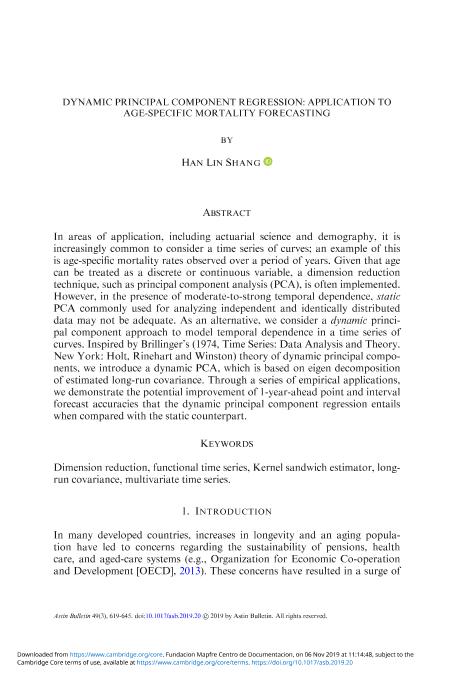Dynamic principal component regression : application to age-specific mortality forecasting

Contenido multimedia no disponible por derechos de autor o por acceso restringido. Contacte con la institución para más información.
| Tag | 1 | 2 | Value |
|---|---|---|---|
| LDR | 00000cab a2200000 4500 | ||
| 001 | MAP20190032063 | ||
| 003 | MAP | ||
| 005 | 20191106165242.0 | ||
| 008 | 191106e20190902usa|||p |0|||b|eng d | ||
| 040 | $aMAP$bspa$dMAP | ||
| 084 | $a6 | ||
| 100 | 1 | $0MAPA20190015141$aLin Shang, Han | |
| 245 | 1 | 0 | $aDynamic principal component regression$b: application to age-specific mortality forecasting$cHan Lin Shang |
| 520 | $aIn areas of application, including actuarial science and demography, it is increasingly common to consider a time series of curves; an example of this is age-specific mortality rates observed over a period of years. Given that age can be treated as a discrete or continuous variable, a dimension reduction technique, such as principal component analysis (PCA), is often implemented. However, in the presence of moderate-to-strong temporal dependence, static PCA commonly used for analyzing independent and identically distributed data may not be adequate. As an alternative, we consider a dynamic principal component approach to model temporal dependence in a time series of curves. Inspired by Brillinger's (1974, Time Series: Data Analysis and Theory. New York: Holt, Rinehart and Winston) theory of dynamic principal components, we introduce a dynamic PCA, which is based on eigen decomposition of estimated long-run covariance. Through a series of empirical applications, we demonstrate the potential improvement of 1-year-ahead point and interval forecast accuracies that the dynamic principal component regression entails when compared with the static counterpart. | ||
| 650 | 4 | $0MAPA20080555306$aMortalidad | |
| 650 | 4 | $0MAPA20080579258$aCálculo actuarial | |
| 650 | 4 | $0MAPA20080602437$aMatemática del seguro | |
| 650 | 4 | $0MAPA20080599300$aTablas de mortalidad | |
| 773 | 0 | $wMAP20077000420$tAstin bulletin$dBelgium : ASTIN and AFIR Sections of the International Actuarial Association$x0515-0361$g02/09/2019 Volumen 49 Número 3 - septiembre 2019 , p.619-645 |

